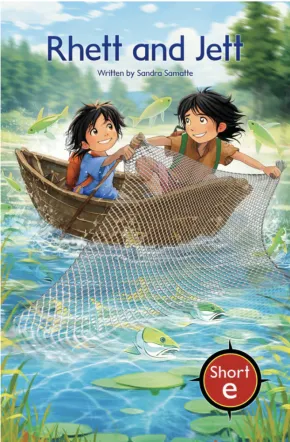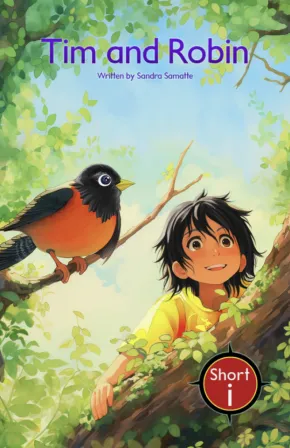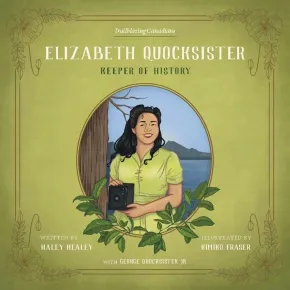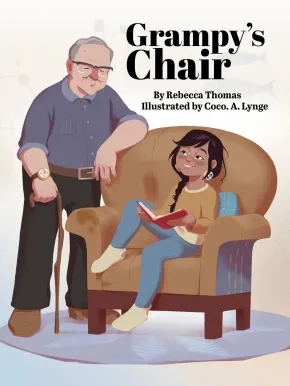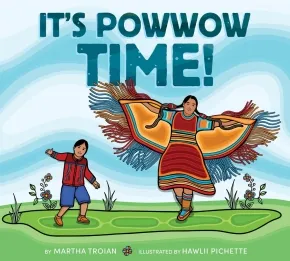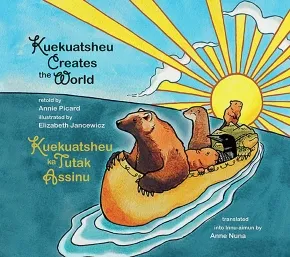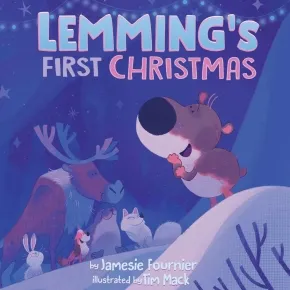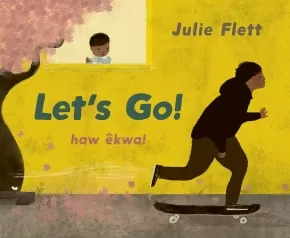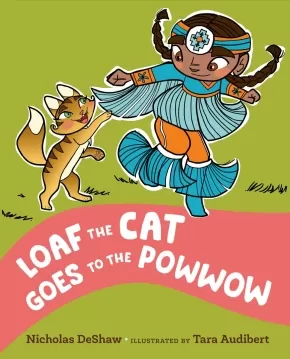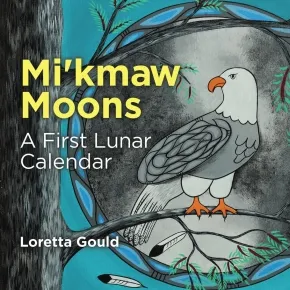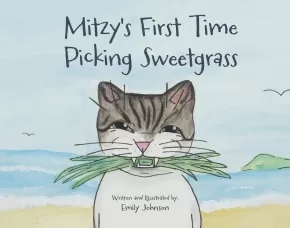
Indigenous Peoples in Canada
106
-
120
of
437 Results;
Sort By
Go To
of 30
Drumbeat Decodable Book Collection: Rhett and Jett
$9.99
Artists:
Format:
Paperback
Text Content Territories:
Indigenous Canadian;
ISBN / Barcode: 9781990297878
Synopsis:
Synopsis:
Read along with Rhett and Jett and learn the Short ‘e’ Vowel.
Educator & Series Information
Recommended for K-2.
This book is part of the Drumbeat Decodable Book Collection Series 1. It is recommended for K-2 for learning short vowels a, e, i, o, and u. Teach children short vowels in the context of cvc (consonant-vowel-consonant) words in the high-frequency and fun Indigenous Decodable Books. Books in this series provide the systematic practice children need to become phonics-wise readers. These stories bring Indigenous content that is much needed in any phonics program. Each book contains a word list, high-frequency words, story words, short vowel words, and two fun activities for extended learning.
Additional Information
Paperback
Drumbeat Decodable Book Collection: Tim and Robin
$9.99
Artists:
Format:
Paperback
Text Content Territories:
Indigenous Canadian;
ISBN / Barcode: 9781990297854
Synopsis:
Synopsis:
Read along with Tim and Robin and learn the Short ‘i’ Vowel.
Educator & Series Information
Recommended for K-2.
This book is part of the Drumbeat Decodable Book Collection Series 1. It is recommended for K-2 for learning short vowels a, e, i, o, and u. Teach children short vowels in the context of cvc (consonant-vowel-consonant) words in the high-frequency and fun Indigenous Decodable Books. Books in this series provide the systematic practice children need to become phonics-wise readers. These stories bring Indigenous content that is much needed in any phonics program. Each book contains a word list, high-frequency words, story words, short vowel words, and two fun activities for extended learning.
Additional Information
Paperback
Elizabeth Quocksister: Keeper of History (PB)
$12.95
Artists:
Format:
Paperback
Text Content Territories:
Indigenous Canadian; First Nations; Kwakwaka'wakw (Kwakiutl); Da'naxda'xw Awaetlala;
ISBN / Barcode: 9781772034851
Synopsis:
Synopsis:
The uplifting true story of Elizabeth Quocksister, a strong Indigenous woman and community leader, who dedicated her life to protecting her language and cultural traditions.
Elizabeth Quocksister (1925–81) had many roles in her life. She was a cultural teacher, a community leader, a dancer, a nurse, a photographer, a residential school survivor, and a mother of ten. Born on the Da’naxda’xw Nation on Knight Inlet on the central coast of British Columbia, Elizabeth spoke fluent Kwak’wala and proudly celebrated her Kwakwaka’wakw culture at a time when the Canadian government actively discouraged Indigenous traditions and the speaking of Indigenous languages. She cared for community members in need and saved many children from the horrors of residential school. She chronicled the daily lives, important events, and changing times of her community through photography—preserving her people’s history and culture for future generations. This inspiring picture book is a beautiful tribute to a proud Indigenous woman whose name deserves to be well-known throughout her community and beyond.
Educator Information
Recommended for ages 4 to 8.
Additional Information
32 pages | 9.00" x 9.00" | Paperback
Grampy's Chair
$23.99
Artists:
Format:
Hardcover
Text Content Territories:
Indigenous Canadian; First Nations; Mi'kmaq;
ISBN / Barcode: 9781773219189
Synopsis:
Synopsis:
A heartwarming story about lifelong love and loss told from the perspective of a grandfather’s favorite chair.
Grampy’s chair sits in the middle of his living room and always keeps an eye on My Love. The Chair is the perfect spot for My Love to learn to read, to play games with her friends, and The Chair is always extra soft when My Love is sick. As My Love grows up, The Chair sees Grampy grow older and My Love must care for him. One day Grampy is gone, and The Chair is moved to a space with only a few things it recognizes (and a few spiders too). Will it see My Love again?
In this poignant story inspired by her own grandfather and his chair, Rebecca Thomas invites readers of all ages to explore love, grief, and the important moments in life that take place in our favorite spots. With lively illustrations from Coco A. Lynge and featuring a heartfelt author’s note, Grampy's Chair takes the readers through loss, and how we can be found again by the ones we love.
Reviews
"Although the author is Mi’kmaw, the story does not directly reference Mi’kmaw culture. Instead, it draws on her personal experience in a mixed-heritage family and offers a heartfelt reflection on the loss of a grandparent. Thomas’s poetic voice invites readers to reflect on someone special and the emotional meaning attached to everyday objects, such as a chair, photograph, or place. Lynge’s gentle illustrations enrich the story’s emotional tone, helping readers connect with the emotions expressed in the story. Suitable for K–3 classrooms, this picture book supports curricular connections in English Language Arts and Social Studies. In ELA, it invites exploration of perspective, voice, symbolism, and story structure. In Social Studies, it can spark discussion around family diversity, intergenerational knowledge, and memory." - Bonny-Lynn D., Elementary School Teacher, Indigenous Books for Schools
Educator Information
Recommended for ages 4 to 7.
This book is included in the Indigenous Books for Schools database from the Association of Book Publishers of BC. It is recommended for K to 3 classrooms for English Language Arts and Social Studies.
Additional Information
36 pages | 7.65" x 10.25" | Hardcover
It Bears Repeating
$23.99
Artists:
Format:
Hardcover
Text Content Territories:
Indigenous Canadian; Inuit;
ISBN / Barcode: 9781774880555
Synopsis:
Synopsis:
This beautifully crafted picture book celebrates one of the world's most awesome animals: the polar bear. Evocative but simple text by award-winning musician and artist Tanya Tagaq is accompanied by striking art in this classic counting book.
Beginning with 1 proud polar bear standing tall and ending with 10 bears waving goodbye, this delightful counting book shows polar bears in all their forms: slippery and fast, crafty and cool, hungry and proud. Tanya has created a story meant to be read aloud, incorporating simple Inuktitut words and using her keen ear for the musical sound of language.
This book is joyful, powerful, clever and striking — much like the bears who sniff, slide, swim, hunt, play and dance through its pages. And when you get to the last page, you won't be able to resist going back to repeat the journey!
Educator Information
Recommended for ages 3 to 7.
Concepts: Counting & Numbers; Animals - Polar Bears.
This book is meant to be read aloud and incorporates simple Inuktitut words.
Additional Information
24 pages | 10.50" x 9.00"
It Is Good to Live in Beautiful Arctic Bay
$16.95
Artists:
Format:
Paperback
Text Content Territories:
Indigenous Canadian; Inuit;
Grade Levels: Preschool; Kindergarten;
ISBN / Barcode: 9781774507933
Synopsis:
Synopsis:
Lucy loves living in Arctic Bay. There are so many things to do in each season! In the winter during "the great darkness," Lucy likes watching the northern lights. She is always excited to welcome the sun back in the spring. In the summer, Lucy can't wait to go blueberry picking, camping, and eat pissi. Follow along with Lucy as she takes readers through the seasons and shares all her favourite things about living in beautiful Arctic Bay.
Reviews
"This book is written in Inuktitut and English, sharing what it is like to live in Arctic Bay. The story explores the seasons (environment, activities) along with Inuit traditions such as hunting. The concept of seasonal traditions is shared through what the inhabitants of Arctic Bay see, what it means to them, and how they celebrate what they see (e.g., “the great darkness” during the winter months). An important part of Inuit culture is hunting and gathering. Students would benefit from learning about the importance of continued access to traditional food, especially given the high cost of processed modern food in remote communities. An inquiry exercise around the location of towns in Nunavut, population size, and community facilities (grocery stores, etc.) would help students understand the difference between rural communities and urban communities. Using online satellite maps would help students see the difference between their community and Arctic Bay." - Alethea S., Elementary School Teacher, Indigenous Books for Schools
Educator & Series Information
Recommended for ages 3 to 5.
Dual-Language: English and Inuktitut.
This book is part of the Community Connections series.
This book is included in the Indigenous Books for Schools database from the Association of Book Publishers of BC. It is recommended for Grades 1 to 4 for English Language Arts, Foods, Science, and Social Studies. On the listing in the database, a content warning is shared: "Mention of seal hunting and that the best part to eat is the brain."
Additional Information
29 pages | 9.00" x 8.00" | Paperback
It's Powwow Time!
$24.99
Artists:
Format:
Hardcover
Text Content Territories:
Indigenous Canadian; First Nations;
ISBN / Barcode: 9780063116665
Synopsis:
Synopsis:
This lyrical and joyful picture book celebrates new experiences and community traditions when a young boy learns to dance at his first powwow. It’s Powwow Time! is for readers of Cynthia Leitich Smith’s Jingle Dancer and Oge Mora’s Thank You, Omu!
Bineshii is looking forward to his first powwow. He wakes up and travels with his mother to the community event. He eats bannock and drinks strawberry juice as he watches the dancers perform. And ever so slowly, Bineshii works his way from the edge of the circle watching the dancers to inside the circle itself, dancing and celebrating with everyone else.
Award-winning journalist Martha Troian’s child-centered text and Hawlii Pichette’s action-packed illustrations build excitement on the page as Bineshii’s curiosity and confidence grows. It’s Powwow Time! explores the rewards of being open to new experiences while also serving as a beautiful and informative introduction to a First Nations powwow.
Educator Information
Recommended for ages 4 to 8.
Keywords/Themes: Early Years (Body and the Senses); Powwows; Self-Esteem; Dance; New Experiences.
This book is a wonderful read-aloud.
Includes an author's note about powwows.
Additional Information
32 pages | 10.00" x 9.00"
Kaiah's Garden
$19.99
Format:
Hardcover
Text Content Territories:
Indigenous Canadian; First Nations; Cree (Nehiyawak);
ISBN / Barcode: 9781443190251
Synopsis:
Synopsis:
An uplifting story of a girl’s connection to her beloved grandmother through the beadwork art they created together.
As she wakes up one dull morning, Kaiah feels as cold and grey as the day. She longs to be with her grandmother again. Kaiah’s life doesn’t feel right without her. But through Kaiah’s treasured bead box — and the beauty it holds — she is with her grandmother, in a garden that is full of colour and love.
This beautiful story from award-winning author Melanie Florence celebrates the universal love between grandmother and child. Featuring bright, breathtaking illustrations from Tsilhqot’in and Syilx artist Karlene Harvey, the book also features back matter about the Indigenous tradition of beading.
Educator Information
Recommended for ages 3 to 8.
This book is available in French: Le jardin de Kaiah.
Additional Information
32 pages | 8.35" x 10.27" | Hardcover
Kuekuatsheu Creates the World / Kuekuatsheu ka Tutak Assinu: (Sheshatshiu dialect)
$24.99
Artists:
Format:
Hardcover
ISBN / Barcode: 9781998802203
Synopsis:
Synopsis:
The story of how the world came to be on the turtle's back can be found in Indigenous cultures throughout North America/Turtle Island. It has many variations. This moving version of the tale—a story of resilience, sacrifice, and friendship—is one that Annie Picard was often told as a child by her maternal grandmother while they lived in nutshimit (on the land) in the Labrador/Quebec peninsula. Picard's lovely re-telling of this traditional Innu story of how little muskrat makes an enormous sacrifice to help the wolverine and his other friends rebuild the world after a great flood is brought vividly to life by Elizabeth Jancewicz's stunning illustrations.
Educator Information
Recommended for ages 4 to 8.
Bilingual: English and Innu-aimun.
Translation into Innu-aimun by Anne Nuna.
Additional Information
36 Pages | 9" x 8" | Hardcover | 2nd Edition
Lemming's First Christmas
$14.95
Artists:
● Tim Mack
Format:
Board Book
Text Content Territories:
Indigenous Canadian; Inuit;
Grade Levels: Preschool; Kindergarten;
ISBN / Barcode: 9781772275438
Synopsis:
Synopsis:
A warm and inviting new take on beloved Christmas traditions.
When Lemming overhears some children singing about Christmas, she can't help but wonder about this new holiday. Qimmiq the sled dog knows all about Christmas. It's the time of year when Santa brings presents to put under your tree!
But...what is a tree? There aren't any trees where Lemming lives, in the treeless Arctic, so she decides to go on the hunt for a tree in order to have her very first Merry Christmas.
Filled with charming holiday illustrations featuring sweet Arctic animals, this book offers a warm and inviting new take on beloved Christmas traditions.
Reviews
"A distinct and skillful take on familiar Yuletide themes." - Kirkus
Educator Information
Recommended for ages 5 and under.
Fountas & Pinnell Text Level Gradient: K
Guided Reading Level: K
Additional Information
28 pages | 8.00" x 8.00" | Hardcover
Let's Go! haw êkwa
$23.95
Artists:
Format:
Hardcover
Text Content Territories:
Indigenous Canadian; First Nations; Cree (Nehiyawak);
ISBN / Barcode: 9781771646109
Synopsis:
Synopsis:
An extraordinary book that celebrates skateboarding, family, and community, from beloved artist and author Julie Flett, a winner of the New York Times / New York Public Library Best Illustrated Children’s Book Award.
Every day, a little boy watches kids pass by on skateboards, and dreams of joining them. One day, his mother brings a surprise: her old skateboard, just for him! haw êkwa! Let’s go! Together, they practice on the sidewalk, at the park, in Auntie’s yard—everywhere. But when it comes time to try the skatepark, the skateboarders crash down like a waterfall. Can he find the confidence to join them?
Let’s Go! features:
- A glossary of Cree words featured in the book, and a Cree refrain (haw êkwa!) repeated throughout
- A note to the reader from Julie Flett about her inspiration for the story
This fun and touching story is a tribute to family, friendship, and perseverance. Julie Flett’s renowned art and powerful text shows a community of support is all around, ready to help each other… go!
Reviews
“Beautifully highlights the value of perseverance along with the joy of skateboarding.”—Horn Book, STARRED Review
“Extraordinary…. A fun read from start to finish, "Let's Go!" is especially and unreservedly recommended as a choice pick for family, daycare center, preschool, elementary school, and community library Self-Esteem and Family Life picture book collections for ages 3-8.”—Midwest Book Review
“Masterful, simple, powerful….a must-read for anyone who skateboards or wants to — or doesn’t.”—Amina Chaudri, Booklist
“Using onomatopoeic language to capture the sounds of the sport, Cree-Métis creator Flett (We All Play) shows the hard work and investment of time that goes into both learning a new skill and becoming ‘a part of something—/ and myself.’”—Publishers Weekly, STARRED review
Educator Information
Recommended for ages 3 to 8.
Curriculum Connections: Sports / Indigenous Languages / Community / Goal-Setting / Risk-Taking / Self-Awareness / Self-Confidence
This book is available in French: On y va!
Recommended in the Indigenous Books for Schools catalogue as a valuable resource for English Language Arts, Art, and Physical and Health Education in kindergarten to grade 3.
Additional Information
44 pages | 11.00" x 9.00" | Hardcover
Loaf the Cat Goes to the Powwow
$24.99
Format:
Hardcover
Text Content Territories:
Indigenous American; Native American; Anishinaabeg;
ISBN / Barcode: 9780593461853
Synopsis:
Synopsis:
A Native American boy's cat surprises him at his first powwow—making for a very special dance indeed!
Loaf the cat loves to play with her boy, and when she’s particularly happy, she’ll make the purr sound for him. She also likes to keep tabs on him, so when he disappears one day, she decides to find him. She follows his smell to a place where there are drums and colors and lots of people—and then she’s excited to see her boy dancing fast, making the ribbons on his regalia twirl beautifully! When he takes a break, Loaf goes to greet him in her special way, making the powwow one her boy will never forget, and worthy of many purrs!
Reviews
“Loaf, a feline protagonist, follows her Ojibwe-cued caretaker, Charlie, to a powwow in this simply told picture book. Fond of rubber bands, paper bags, and ribbon, Loaf takes note when ‘my boy started putting all these ribbons on his clothes.’ . . . In an animated picture book debut, Anishinaabe author DeShaw walks readers through the powwow’s Grand Entry, told through the perspective of Loaf the cat. . . . Audibert (the Jo Jo Makoons series), of Wolastoqiyik and French heritage, aptly capture the energy of a cat at play and a boy taking part in the powwow—and the two displaying affection for each other.” —Publishers Weekly
Educator Information
Recommended for ages 3 to 7.
Additional Information
32 pages | 8.44" x 10.25" | Hardcover
Metis Like Me
$24.99
Artists:
Format:
Hardcover
Text Content Territories:
Indigenous Canadian; Métis;
ISBN / Barcode: 9781774881125
Synopsis:
Synopsis:
Whether or not you're Métis, there's so much to experience and learn about this amazing Indigenous culture — take a picture book journey into Métis crafts, music and cooking with friends who love to share.
Are you Métis like me? A group of children of Métis descent share and explore all the ways they celebrate and experience their heritage — enjoying traditional foods like bannock bread and Saskatoon berries; crafting with beads; sharing stories, dance, music and songs. Each child shares a different way they enjoy honoring their backgrounds and weaving parts of the rich tapestry that makes up Métis culture. One child, though, has grown up disconnected from their history, and can't join in with the others in the same way. But they soon see it's never too late to learn, celebrate or become a part of a community in which Métis and non-Métis alike can discover the richness of an often-overlooked culture.
This rhythmic, jubilant book will encourage young readers of all backgrounds to celebrate their own heritage and learn more about Métis history, and contains back matter including an author's note, recipe and dictionary to further inspire.
Educator Information
Recommended for ages 3 to 7.
This book is available in French: Nous sommes Métis.
Additional Information
40 pages | 9.43" x 9.31" | Hardcover
Mi'kmaw Moons: A First Lunar Calendar (BB)
$16.95
Artists:
Format:
Board Book
Text Content Territories:
Indigenous Canadian; First Nations; Mi'kmaq;
Grade Levels: Preschool; Kindergarten;
ISBN / Barcode: 9781459507456
Synopsis:
Synopsis:
This board book presents the months of the Mi’kmaw lunar calendar to very young children and their parents. Mi’kmaw artist Loretta Gould’s art illustrates each of the 12 Mi’kmaw moons through the changing seasons in Mi’kma’ki. Each month is named after events in the natural world – from Snow Blinding Time through Frogs Croaking Time and Berry Ripening Time. Each month’s illustration is accompanied by its name in Mi’kmaw and English.
Loretta Gould’s art, first published in Mi’kmaw Moons: A First Lunar Calendar has won high praise from reviewers, and the book has received numerous awards.
Educator Information
For ages 2 to 5.
Includes names of the months in English and Mi'kmaw.
This is the board book version of Mi'kmaw Moons: The Seasons in Mi'kma'ki.
Additional Information
6.53" x 6.53" | Board Book
Mitzy's First Time Picking Sweetgrass
$14.95
Artists:
Format:
Paperback
Text Content Territories:
Indigenous Canadian;
ISBN / Barcode: 9781777854287
Synopsis:
Synopsis:
This book is about a curious kitty who gets to experience her first time sweetgrass picking with her mom.
Educator Information
Recommended for ages 4 to 6.
Additional Information
28 pages | 9.25" x 7.28" | Paperback
Sort By
Go To
of 30

